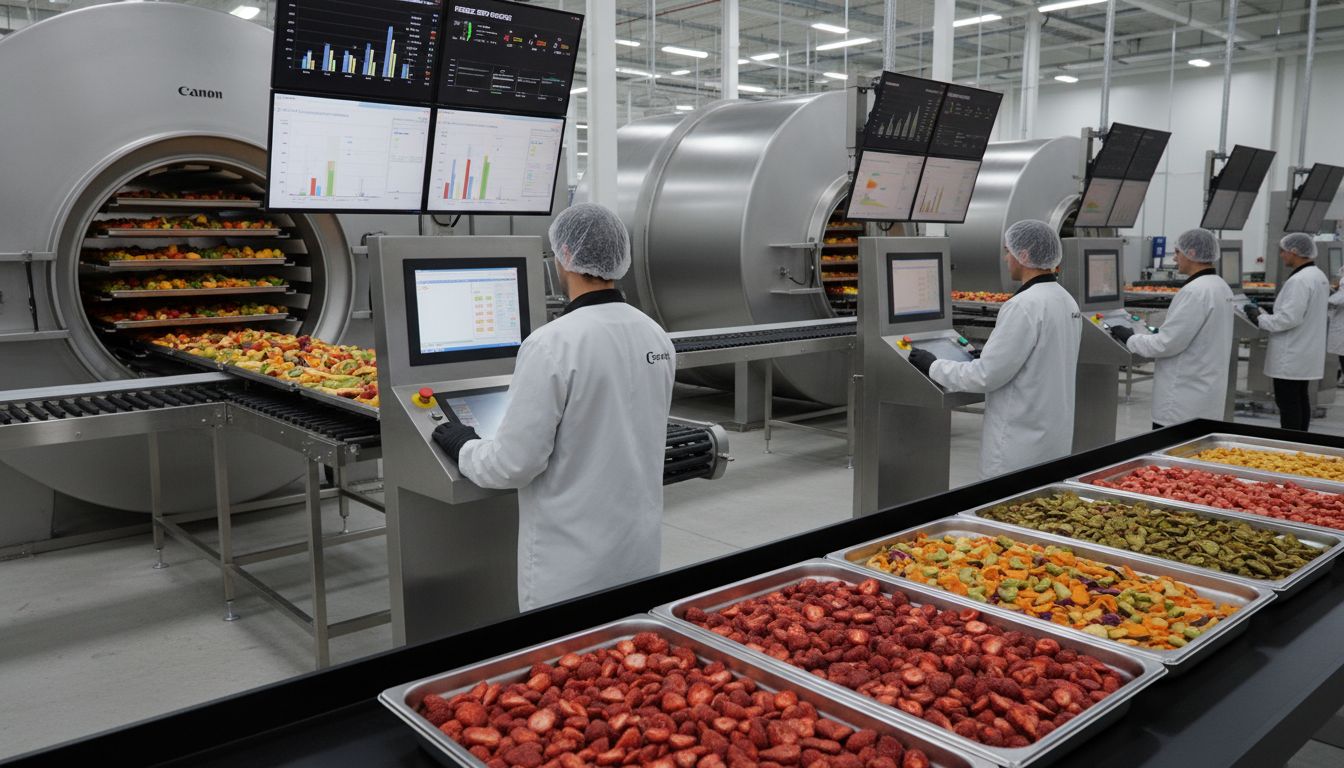Over 95 percent of the water in food or medicine can be removed while still preserving taste, texture, and nutritional content. Freeze drying has become a powerful tool for extending shelf life and protecting valuable materials in households, research, and industry. Understanding how this advanced process works helps you see why so many experts and home enthusiasts now turn to freeze drying for dependable, long-lasting results.
Table of Contents
- What Is Freeze Drying And How It Works
- Stages Of The Freeze Drying Process Explained
- Freeze Drying For Foods And Candies
- Benefits And Limitations Of Freeze Drying
- Common Mistakes And Best Practices
Key Takeaways
| Point | Details |
|---|---|
| Freeze Drying Process | Involves three stages: freezing, primary drying, and secondary drying, crucial for preserving product integrity. |
| Nutritional Preservation | Maintains nearly 97% of the original nutritional profile and flavor of products, making it ideal for food and pharmaceuticals. |
| Operational Challenges | The process involves high costs and energy requirements, necessitating careful consideration of economic feasibility for commercial applications. |
| Common Mistakes | Inadequate freezing and improper storage are critical errors that can compromise the effectiveness of freeze drying, highlighting the need for meticulous procedures. |
What Is Freeze Drying and How It Works
Freeze drying is a sophisticated preservation technique that transforms how we store and maintain various products by removing moisture through an ingenious scientific process. According to NCBioNetwork, freeze drying (also known as lyophilization) is a method that extracts water from materials by first freezing them and then reducing surrounding pressure to enable direct sublimation of frozen water from solid to gas state.
The process works through three critical stages: freezing, primary drying, and secondary drying. During freezing, the product is cooled to temperatures well below zero, typically around -40°F or lower, which transforms all water content into solid ice crystals. As University of Minnesota Extension explains, this unique technique allows water molecules to transition directly from ice to vapor without passing through the liquid phase, effectively preserving the original structure and nutritional content of the material.
Freeze drying offers remarkable benefits across multiple industries. In pharmaceuticals, it ensures long-term stability of sensitive drug products. For food preservation, it extends shelf life while maintaining original flavor, color, and nutritional value. The process is particularly valuable for preserving delicate items like fruits, vegetables, meats, and even complete meals.
 Unlike traditional dehydration methods, freeze drying maintains nearly 97% of the product’s original nutritional profile, making it a superior preservation technique for industries ranging from food production to medical research.
Unlike traditional dehydration methods, freeze drying maintains nearly 97% of the product’s original nutritional profile, making it a superior preservation technique for industries ranging from food production to medical research.
For those interested in learning more about the diverse applications of this fascinating process, check out our complete guide to foods you can freeze dry.
Stages of the Freeze Drying Process Explained
Freeze drying is a precision-driven process that transforms moisture removal through three meticulously designed stages. According to NCBioNetwork, the freeze-drying process involves three critical stages: freezing, primary drying, and secondary drying, each playing a crucial role in preserving the material’s integrity and quality.
During the freezing stage, materials are rapidly cooled to extremely low temperatures, typically between -40°F and -50°F. As Frontiers in Marine Science explains, this rapid freezing creates uniform ice crystals throughout the product, which is fundamental to maintaining the material’s structural composition. The goal here is to solidify all water content while preventing potential cellular damage that could occur with slower cooling methods.
The primary drying stage follows, where the frozen material is placed under vacuum conditions and gentle heat is applied. This unique environment enables sublimation - the direct transition of water from solid ice to vapor without passing through the liquid state. During this phase, approximately 95% of the water is removed, dramatically reducing the product’s moisture content while preserving its original shape, flavor, and nutritional characteristics. The secondary drying stage then removes any remaining bound moisture, ensuring complete dehydration and long-term stability.
If you’re curious about selecting the right equipment for this intricate process, our guide to the best freeze dryers provides comprehensive insights into choosing the most suitable technology for your specific needs.
Freeze Drying for Foods and Candies
Freeze drying has revolutionized food preservation, offering an extraordinary method for transforming a wide variety of foods and candies into lightweight, long-lasting delicacies. According to University of Minnesota Extension, this technique is an incredibly effective approach for preserving foods by removing moisture through sublimation, which simultaneously extends shelf life while maintaining the product’s nutritional value and original flavor profile.
The process is particularly remarkable for candies and foods because it preserves the original structural integrity and sensory characteristics. Texture, color, and taste remain virtually unchanged, making freeze-dried products incredibly appealing to consumers. As Clemson University’s Home & Garden Information Center notes, while initially a commercial food manufacturing technique, freeze drying is now becoming increasingly accessible for home use, expanding its potential applications across different culinary and preservation contexts.
Freeze-dried foods and candies offer numerous advantages that set them apart from traditional preservation methods. They are incredibly lightweight, making them perfect for backpacking, camping, emergency food supplies, and space-efficient storage. The absence of moisture prevents bacterial growth, allowing products to remain stable at room temperature for extended periods. Candies, in particular, undergo fascinating transformations - they become crispy, intensely flavored versions of their original selves, creating unique textural experiences that many food enthusiasts find irresistible.
If you’re curious about the specific types of candies that work best with this preservation method, our guide to what candy you can freeze dry provides comprehensive insights into selecting the perfect sweet treats for this innovative process.
Benefits and Limitations of Freeze Drying
Freeze drying represents a remarkable preservation technology with extraordinary advantages and some notable challenges. According to Wisdom Library, this innovative process offers enhanced stability, extended shelf life, flavor preservation, and rapid rehydration, making it an exceptional method for handling sensitive products across multiple industries.
The scientific advantages of freeze drying are particularly profound when considering its impact on product integrity. As Frontiers in Marine Science explains, the technique demonstrates minimal denaturation of proteins compared to alternative drying methods, which means products maintain their original cellular structure and nutritional composition. This makes freeze drying especially valuable for delicate materials in pharmaceuticals, food sciences, and biological research.
However, the process is not without its limitations. The most significant challenges include high operational costs, substantial energy requirements, and the need for specialized equipment. While freeze-dried products offer unparalleled preservation, the initial investment and processing time can be substantial. Industrial and commercial applications must carefully weigh these economic considerations against the long-term benefits of extended product shelf life and maintained quality.
To dive deeper into understanding the nuanced applications of this technology, our guide to the benefits of freeze drying provides comprehensive insights into navigating its complex landscape.
Common Mistakes and Best Practices
Navigating the freeze-drying process requires precision and careful attention to detail. According to University of Minnesota Extension, one of the most critical mistakes in freeze-drying is inadequate freezing, which can lead to incomplete sublimation and compromise the entire preservation process. The initial freezing stage sets the foundation for successful moisture removal, making it crucial to ensure thorough and rapid cooling of the product.
Proper equipment and technique are paramount in achieving optimal results. Ohio State University emphasizes the importance of using a manufactured freeze-drying unit and following meticulous procedures. Best practices include maintaining appropriate vacuum levels, applying rapid freezing techniques, and implementing strategic post-processing storage methods. After the freeze-drying process, it’s essential to store products in specialized containers like food-grade Mylar bags or glass jars with oxygen absorbers to maintain their quality and extend shelf life.
The most common pitfalls in freeze-drying often stem from overlooking seemingly minor details.
![]() Moisture reabsorption can quickly destroy the preservation work, so selecting the right storage environment is as critical as the drying process itself. Home and commercial operators alike must be vigilant about maintaining a controlled, dry environment. This means investing in proper sealing techniques, using appropriate moisture barriers, and monitoring storage conditions to prevent humidity from compromising the carefully preserved products.
Moisture reabsorption can quickly destroy the preservation work, so selecting the right storage environment is as critical as the drying process itself. Home and commercial operators alike must be vigilant about maintaining a controlled, dry environment. This means investing in proper sealing techniques, using appropriate moisture barriers, and monitoring storage conditions to prevent humidity from compromising the carefully preserved products.
If you’re looking to dive deeper into the intricacies of freeze-drying equipment and techniques, our guide to freeze-drying machines offers comprehensive insights into selecting and using the right technology for your specific needs.
Unlock the Full Potential of Freeze Drying for Your Products
Understanding the delicate balance of freezing, primary drying, and secondary drying stages is key to mastering freeze drying. The challenge many face is achieving consistent product quality while managing high operational costs and complex equipment needs. If you want to preserve flavor, nutrition, and texture like a pro without the typical headaches of freeze drying process management, there is a better way.
Space Man is Canada’s trusted freeze dried candy manufacturer and distributor, offering expert private labeling, co-packing, and packaging solutions designed specifically for delicate freeze dried foods and sweets. Whether you are a business aiming for flawless product stability or a consumer looking for superior freeze dried treats, we take the technical stress off your plate to deliver products that meet the highest standards.

Take control of your freeze drying goals today by partnering with true industry specialists. Visit Space Man to explore how our comprehensive services can simplify complex freeze drying challenges for you. Also check out our best freeze dryer guide and guide to freeze-drying machines for valuable insights on equipment and technique. Start your journey to premium preserved products now and experience the difference excellence makes.
Frequently Asked Questions
What are the main stages of the freeze drying process?
The freeze drying process consists of three critical stages: freezing, primary drying, and secondary drying. In the freezing stage, materials are cooled to very low temperatures to form ice crystals. During primary drying, the product is placed under vacuum conditions where sublimation occurs, removing approximately 95% of the water. The secondary drying stage removes any remaining bound moisture, ensuring complete dehydration and enhancing long-term stability.
How does freeze drying compare to traditional dehydration methods?
Freeze drying is superior to traditional dehydration methods as it retains nearly 97% of a product’s nutritional profile, flavor, and color. Unlike traditional drying, which can cause significant nutrient loss and texture changes, freeze drying preserves the original structure and sensory characteristics of the food, making it ideal for sensitive items like fruits, vegetables, and proteins.
What advantages does freeze drying offer for food preservation?
Freeze drying offers numerous advantages for food preservation, including extended shelf life, enhanced flavor preservation, and rapid rehydration capabilities. The process prevents bacterial growth by removing moisture, allowing products to remain stable at room temperature for long periods, making it perfect for emergency food supplies and outdoor activities.
What are the common mistakes to avoid when freeze drying?
Common mistakes in freeze drying include inadequate freezing, which can lead to incomplete sublimation, and improper storage methods. It’s essential to use a manufactured freeze-drying unit, maintain appropriate vacuum levels, and store freeze-dried products in moisture-proof containers to avoid moisture reabsorption and preserve quality.

